General, Sir John Monash, Personal Files Book 19, 23 June - 7 July 1918 - Part 12
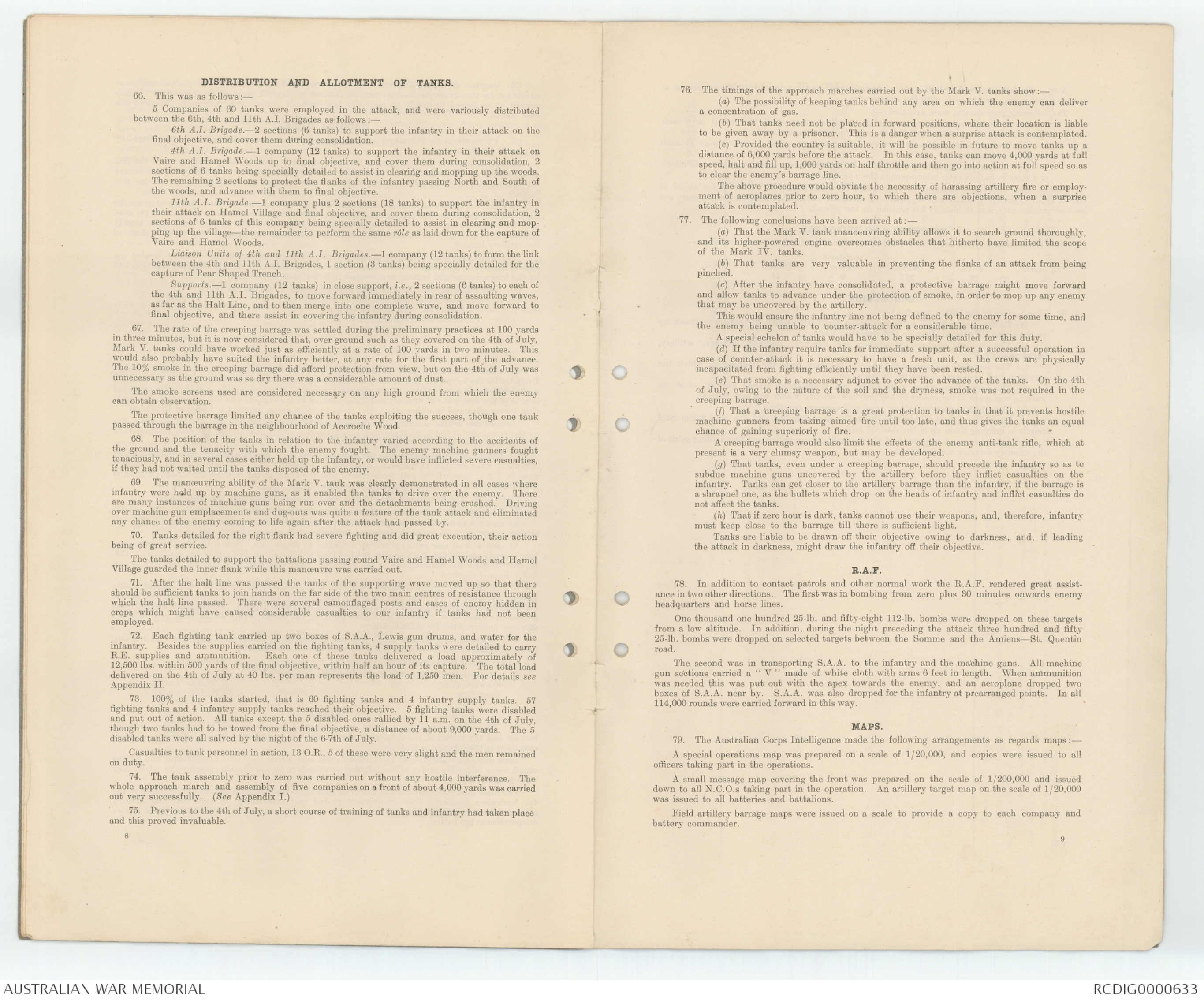
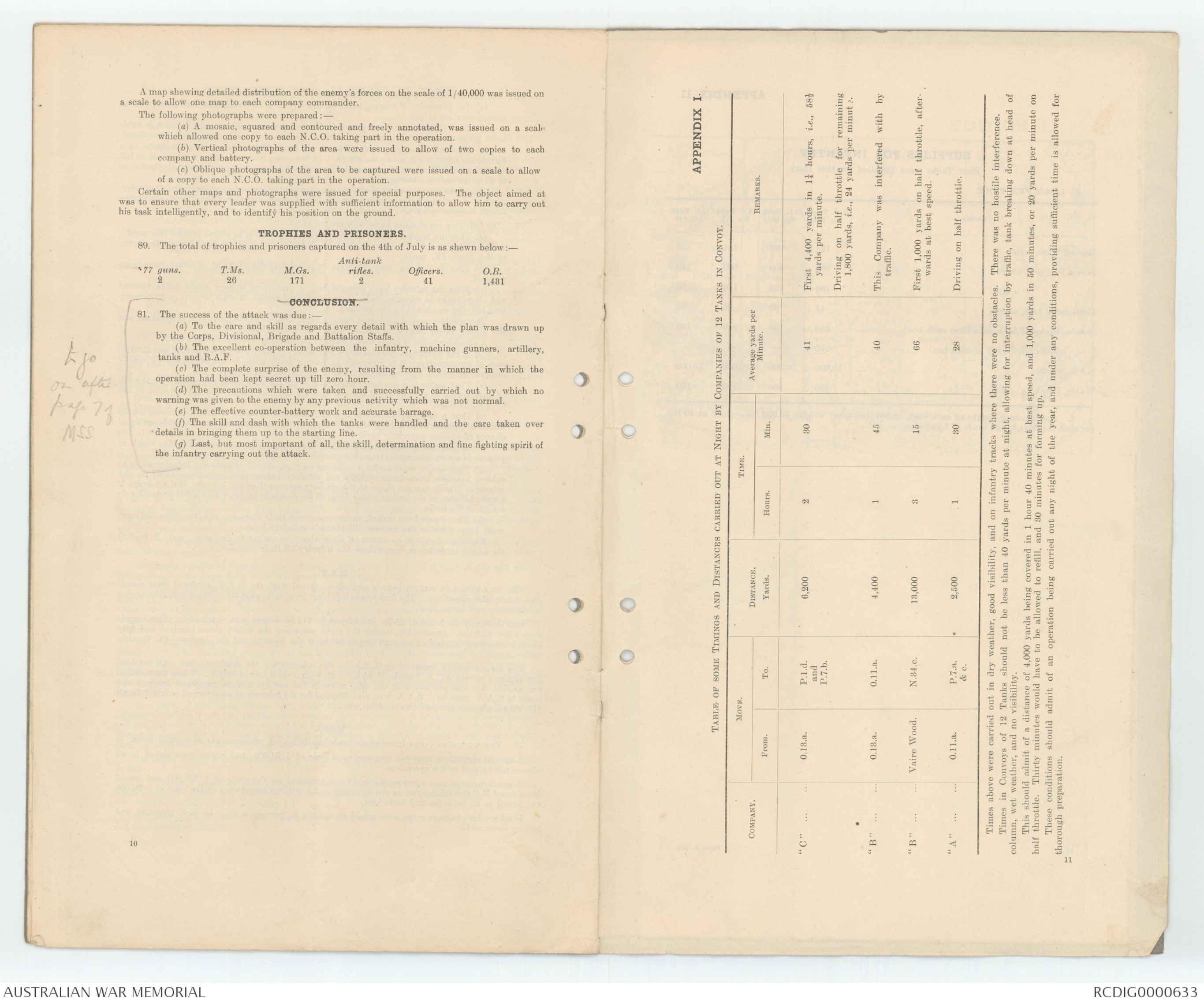
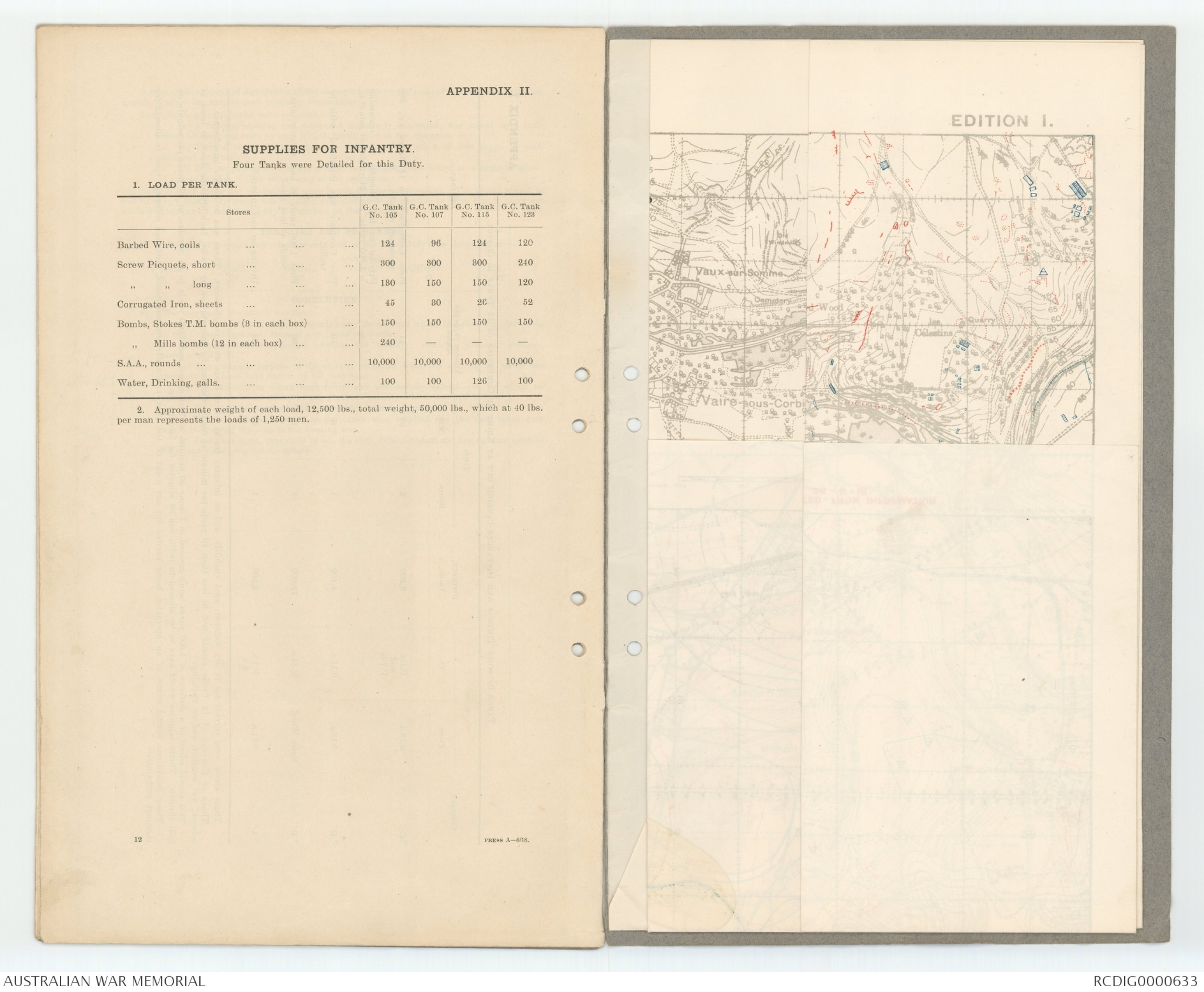
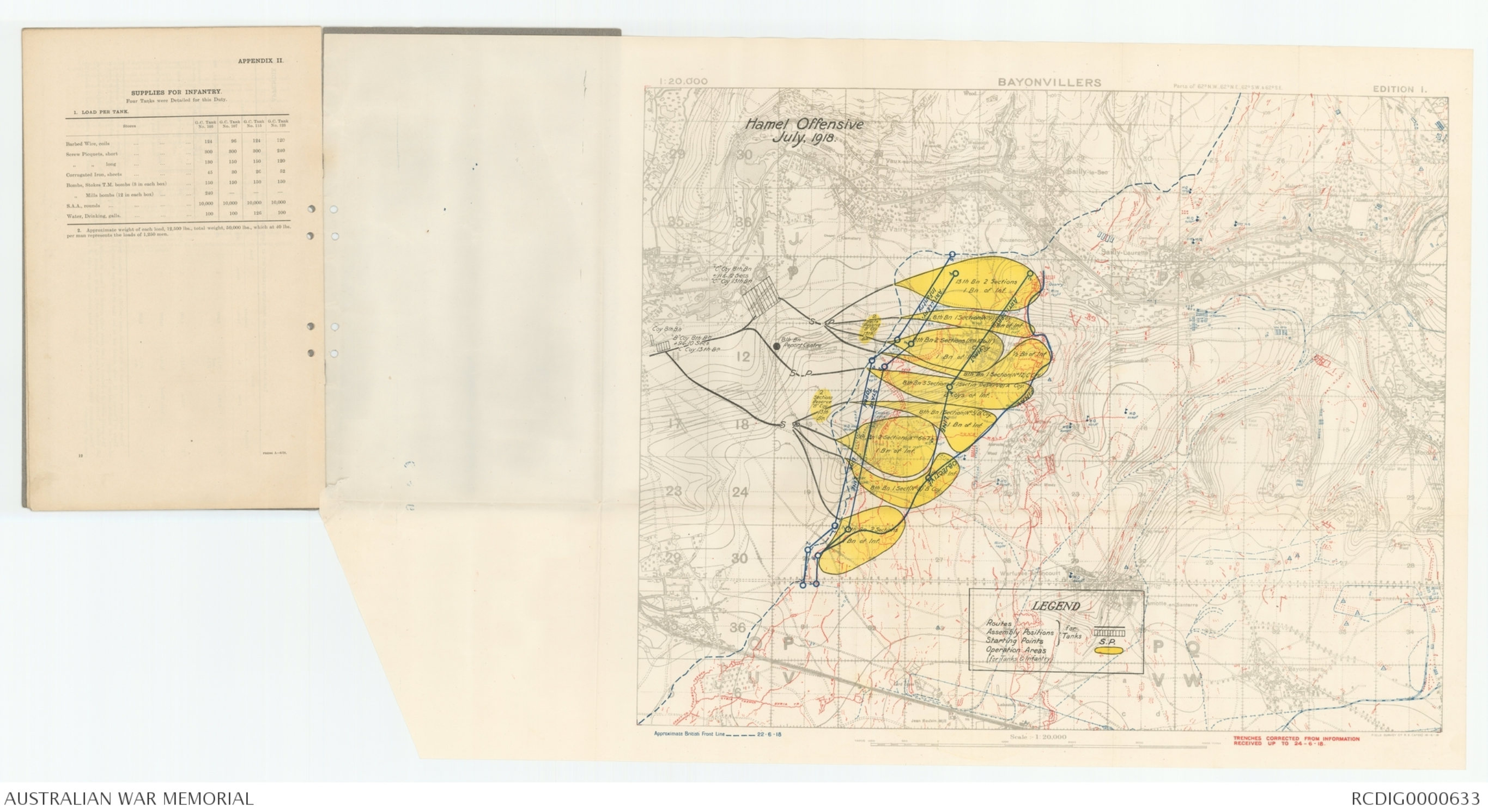
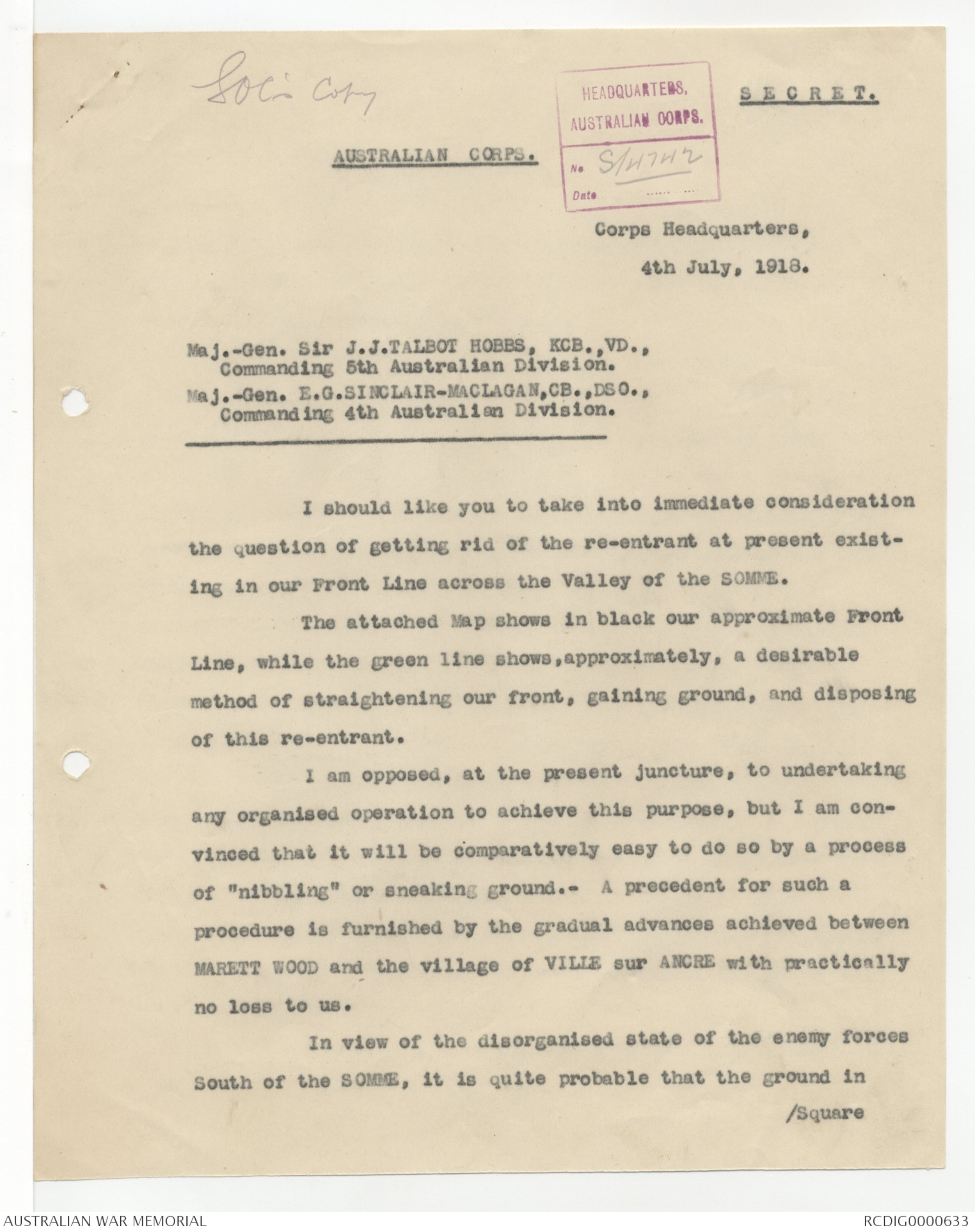
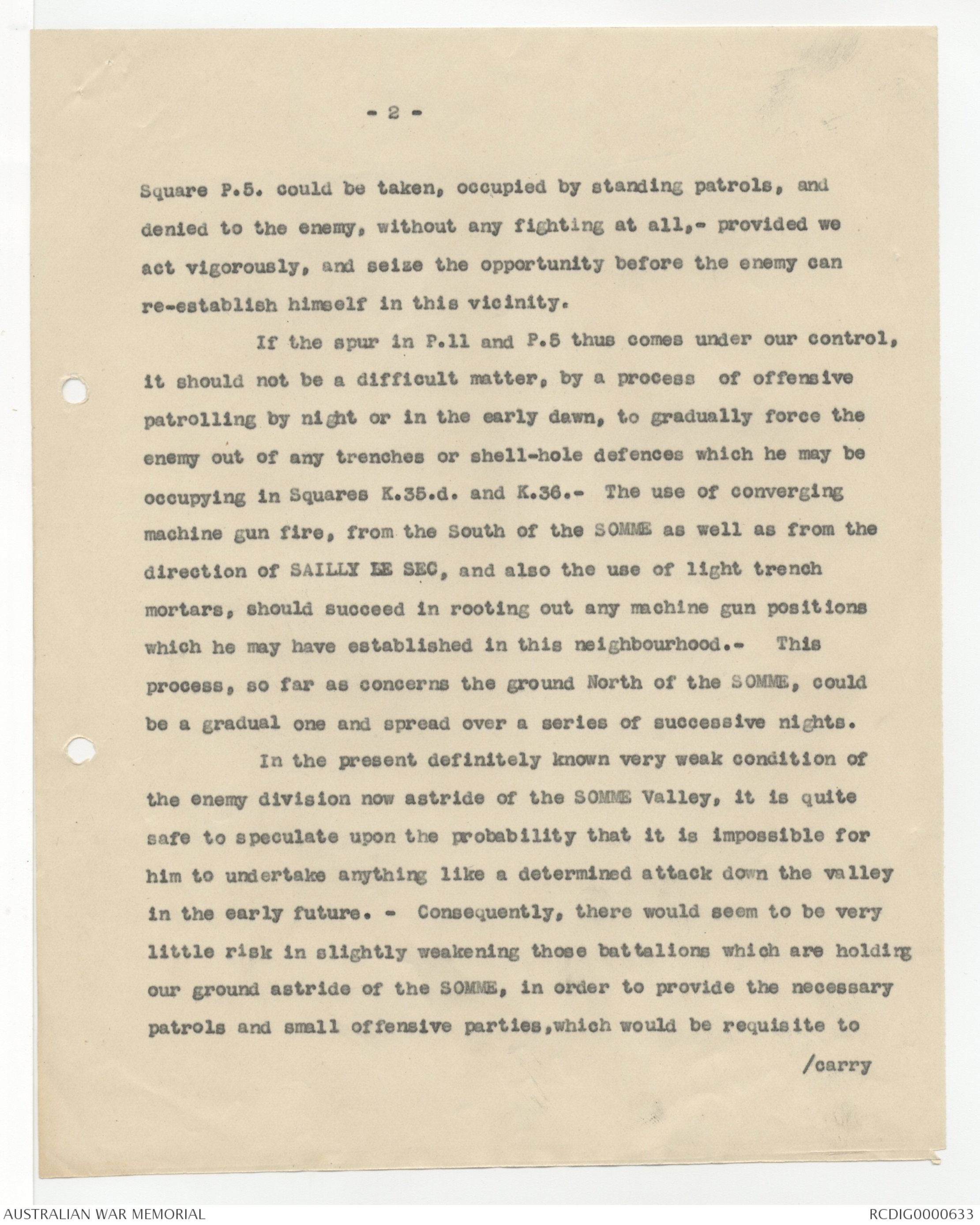
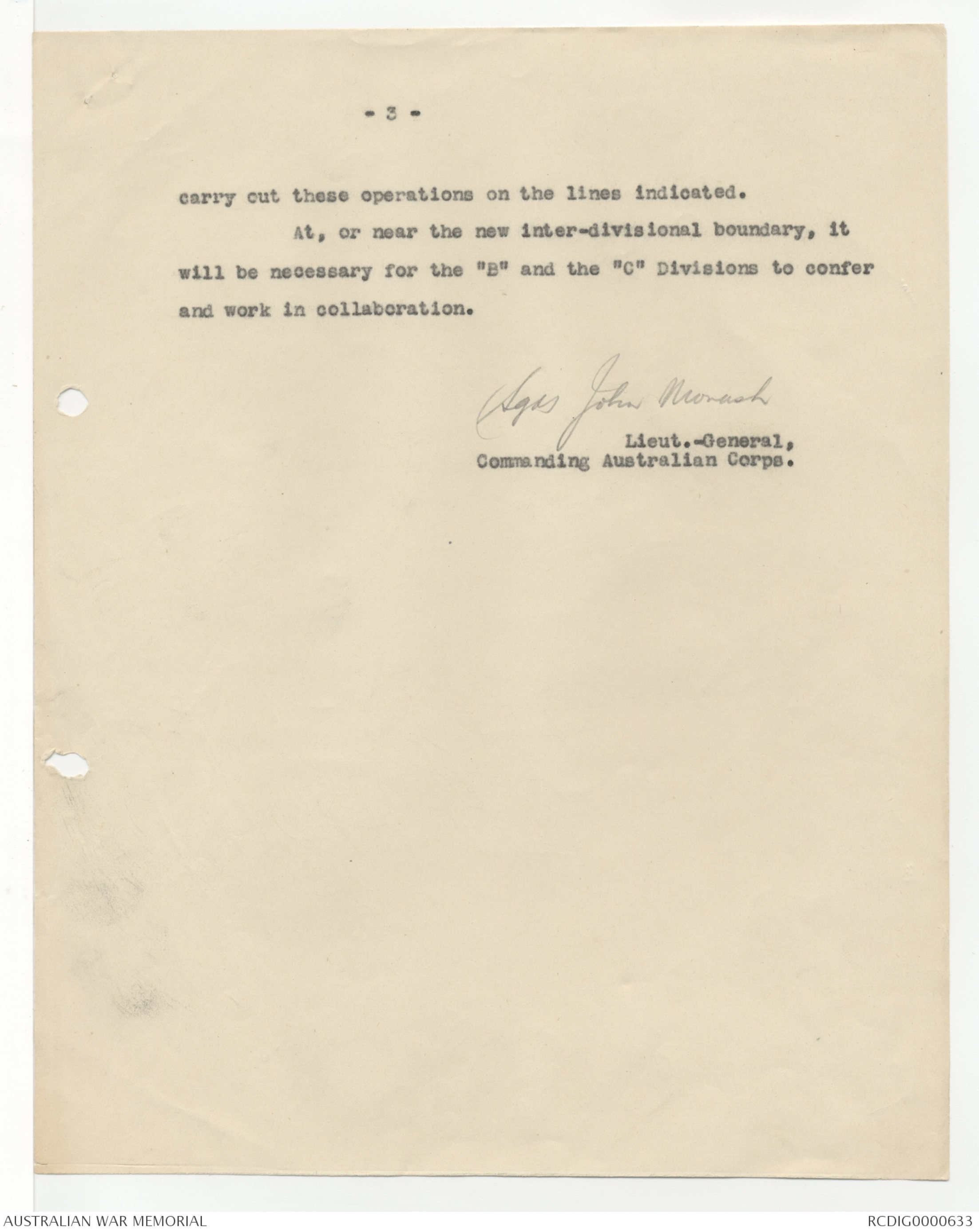
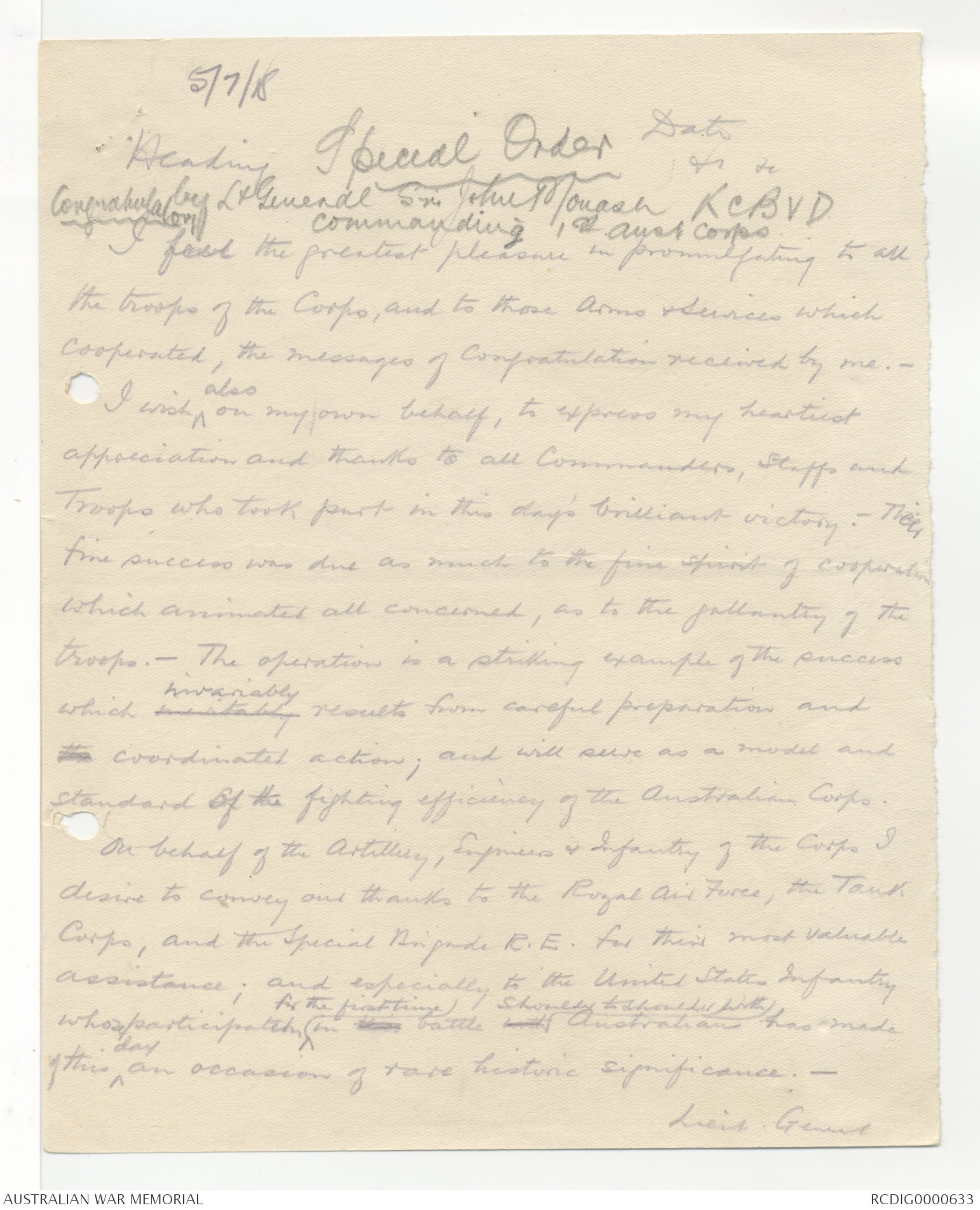
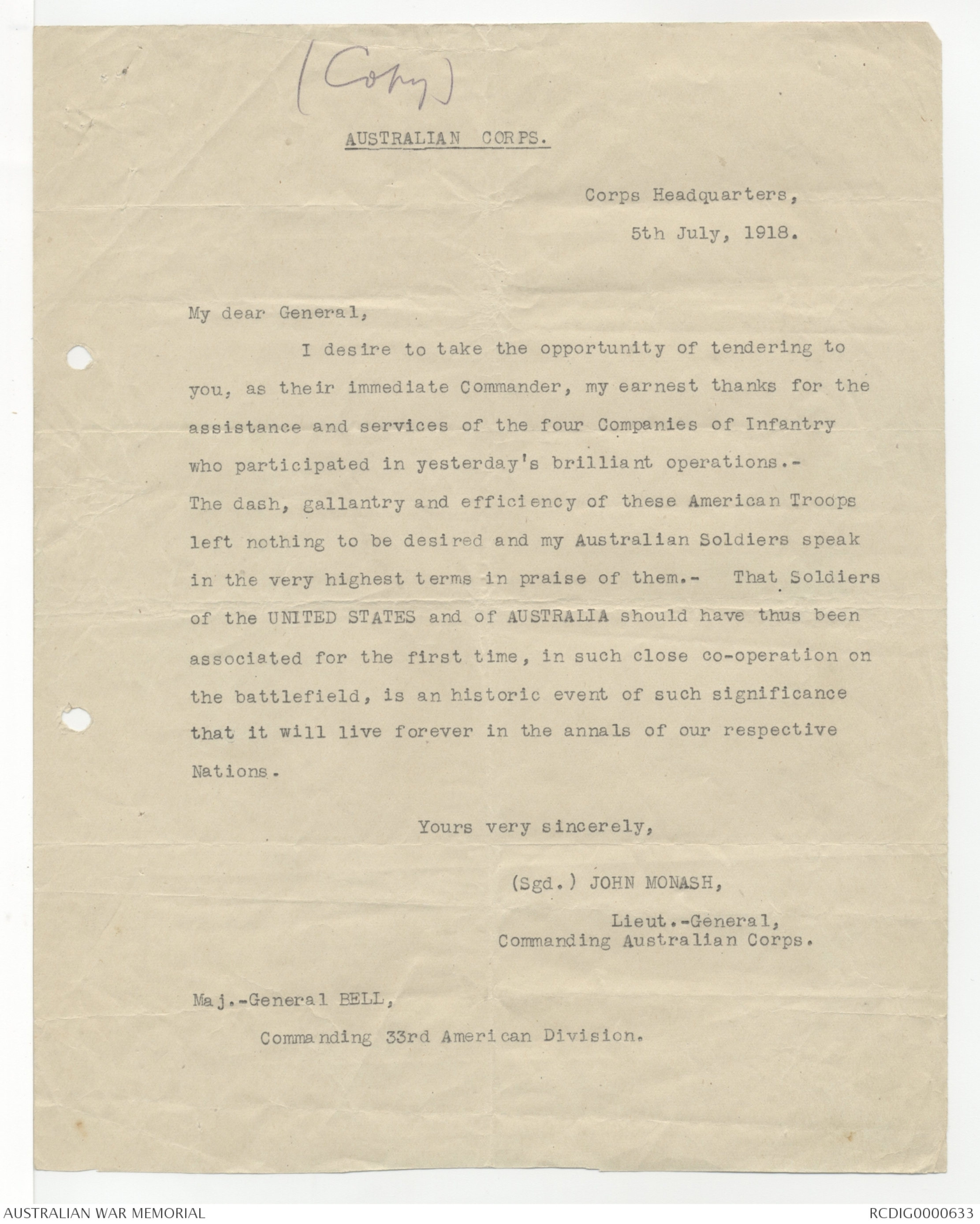
Printed document - see original document
Printed document - see original document
[* to go
on after
page 7 of
MSS*]
Printed document - see original document
APPENDIX II
SUPPLIES FOR INFANTRY
Four Tanks were Detailed for this Duty.
| 1. LOAD PER TANK | ||||
|
Stores |
G.C. Tank |
G.C. Tank |
G.C. Tank |
G.C. Tank |
| Barbed Wire, coils |
124 |
96 |
124 |
120 |
| Scew Picquets, short |
800 |
800 |
800 |
240 |
| “ “ long |
130 |
150 |
150 |
120 |
| Corrugated Iron, sheets |
45 |
80 |
26 |
52 |
| Bombs, Stokes T.M. bomb (8 in each box) |
150 |
150 |
150 |
150 |
| “ Mills bombs (12 in each box) |
240 |
- |
- |
- |
| S.A.A., rounds |
10,000 |
10,000 |
10,000 |
10,000 |
| Water, Drinking, galls. |
100 |
100 |
126 |
100 |
| 2. Approximate weight of each load 12,500 lbs., total weight, 50,000 lbs., which at 40 lbs. Per man represents the loads of 1,250 men. |
||||
Map - see original document
APPENDIX II
SUPPLIES FOR INFANTRY
Four Tanks were Detailed for this Duty.
| 1. LOAD PER TANK | ||||
|
Stores |
G.C. Tank |
G.C. Tank |
G.C. Tank |
G.C. Tank |
| Barbed Wire, coils |
124 |
96 |
124 |
120 |
| Scew Picquets, short |
800 |
800 |
800 |
240 |
| “ “ long |
130 |
150 |
150 |
120 |
| Corrugated Iron, sheets |
45 |
80 |
26 |
52 |
| Bombs, Stokes T.M. bomb (8 in each box) |
150 |
150 |
150 |
150 |
| “ Mills bombs (12 in each box) |
240 |
- |
- |
- |
| S.A.A., rounds |
10,000 |
10,000 |
10,000 |
10,000 |
| Water, Drinking, galls. |
100 |
100 |
126 |
100 |
| 2. Approximate weight of each load 12,500 lbs., total weight, 50,000 lbs., which at 40 lbs. Per man represents the loads of 1,250 men. |
||||
Hamel Offensive
July, 1918.
Map - see original document
[*GOC Copy*]
SECRET.
[*STAMP
HEADQUARTERS
AUSTRALIAN CORPS
No S14742
Date*]
AUSTRALIAN CORPS.
Corps Headquarters,
4th July, 1918.
Maj.-Gen. Sir J. J. TALBOT HOBBS, KCB., VD.,
Commanding 5th Australian Division.
Maj.-Gen. E. G. SINCLAIR-MACLAGAN, C B., DSO.,
Commanding 4th Australian Division
I should like you to take into immediate consideration
the question of getting rid of the re-entrant at present existing
in our Front Line across the Valley of the SOMME.
The attached map shows in black our approximate Front
Line, while the green line shows, approximately, a desirable
method of straightening our front, gaining ground, and disposing
of this re-entrant.
I am opposed, at the present juncture, to undertaking
any organised operation to achieve this purpose, but I am convinced
that it will be comparatively easy to do so by a process
of "nibbling" or sneaking ground.- A precedent for such a
procedure is furnished by the gradual advances achieved between
MARETT WOOD and the village of VILLE sur ANCRE with practically
no loss to us.
In view of the disorganised state of the enemy forces
South of the SOMME, it is quite probable that the ground in
/Square
-2-
Square P.B. could be taken, occupied by standing patrols, and
denied to any enemy, without any fighting at all,- provided we
set vigorously, and seize the opportunity before the enemy can
re-establish himself in this vicinity.
If the spur in P.11 and P.5 thus comes under our control,
it should not be a difficult matter, by a process of offensive
patrolling by night or in the early dawn, to gradually force the
enemy out of any trenches or shell-hole defences which he may be
occupying in Squares K.55.d. and K.36.- The use of converging
machine gun fire, from the South of the SOMME as well as from the
direction of SAILLY LE SEC, and also the use of light trench
mortars, should succeed in rooting out any machine gun positions
which he may have established in this neighbourhood.- This
process, so far as concerns the ground North of the SOMME, could
be gradual one and spread over a series of successive nights.
In the present definitely known very weak condition of
the enemy division now astride of the SOMME Valley, it is quite
safe to speculate upon the probability that it is impossible for
him to undertake anything like a determined attack down the valley
in the early future. - Consequently, there would seem to be very
little risk in slightly weakening those battalions which are holding
our ground astride of the SOMME, in order to provide the necessary
patrols and small offensive parties,which would be requisite to
/carry
-3-
carry out these operations on the lines indicated.
At, or near the new inter-divisional boundary, it
will be necessary for the "B" and the "C" Divisions to confer
and work in collaboration.
Sgts John Monash
Lieut.-General,
Commanding Australian Corps.
5/7/18
Heading
Special Order
Date
Congratulations
by Lt. General Sr John Monash KCBVD
Commanding 1st Aust Corps
I feel the greatest pleasure in promulgating to all
the troops of the Corps, and to those Arms & Services which
cooperated, the messages of Congratulations received by me. -
I wish ^also on my own behalf, to express my heartiest
appreciation and thanks to all Commanders, Staffs, and
Troops who took part in this day's brilliant victory.- Their
fine success was due as much to the fine spirit of cooperation
which animated all concerned, as to the gallantry of the
troops. - The operation is a striking example of the success
which inevitably invariably results from careful preparations and
the coordinated action, and will sure as a model and
standard of the fighting efficiency of the Australian Corps.
On Behalf of the Artillery, Engineers & Infantry of the Corps I
desire to convey out thanks to the Royal Air Force, the Tank
Corps, and the Special Brigade R.E. for their most valuable
assistance; and especially to the United States Infantry
whose participation ^for the first time in this battle with ^shoulder to shoulder with Australians has made
of this ^day an occasion of rare historic significance. -
Lieut. General
[*(Copy)*]
AUSTRALIAN CORPS
Corps Headquarters,
5th July, 1918.
My dear General,
I desire to take the opportunity of tendering to
you, as their immediate Commander, my earnest thanks for the
assistance and services of the four Companies of Infantry
who participated in yesterday's brilliant operations. -
The dash, gallantry and efficiency of these American Troops
left nothing to be desired and my Australian Soldiers speak
in the very highest terms of praise of them. - That Soldiers
of the UNITED STATES and of AUSTRALIA should have thus been
assisted the first time, in such close co-operation on
the battlefield, is an historic event of such significance
that it will live forever in the annals of our respective
Nations.
Yours very sincerely,
(Sgd.) JOHN MONASH
Lieut.-General,
Commanding Australian Corps.
Maj.-General BELL,
Commanding 33rd American Division.
 Sam scott
Sam scottThis transcription item is now locked to you for editing. To release the lock either Save your changes or Cancel.
This lock will be automatically released after 60 minutes of inactivity.